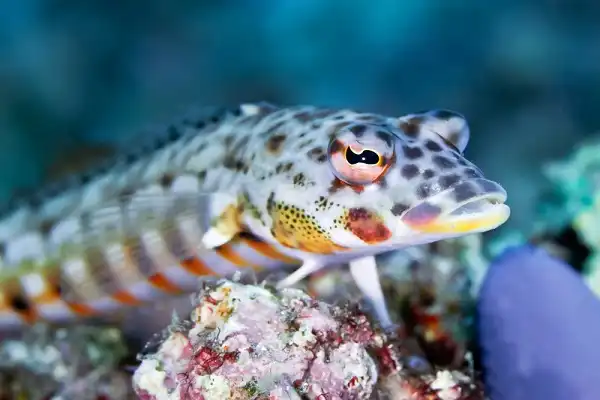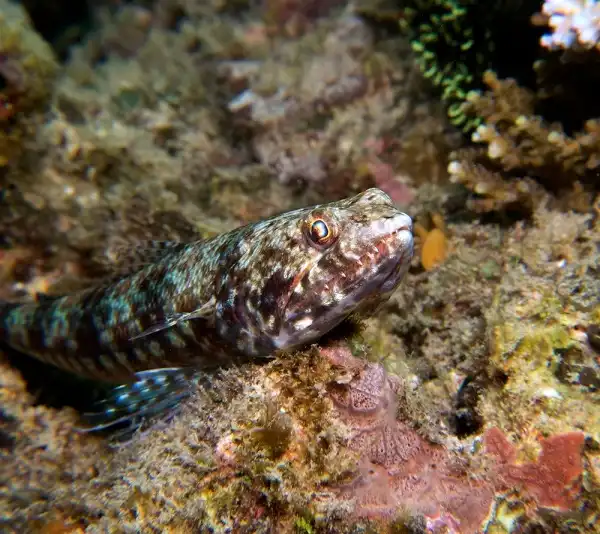The lizardfish might be an unassuming creature, but do not let its small size fool you: these expert predators have been around for hundreds of millions of years and are perfectly adapted to their unique environment. From the tropical shallows of coral reefs to the remote depths of ocean trenches many thousands of meters below the surface, members of this diverse family can usually be found lurking on the seafloor waiting patiently for their next unsuspecting meal. In today’s blog post, we take a closer look at what makes these fascinating animals so well suited to life beneath the waves.

Lizardfish Description
The lizardfish is a master of disguise, blending seamlessly into its surroundings with its mottled brown or grayish-green coloration and patterned markings. Their elongated, streamlined bodies are designed for stealth, enabling them to glide silently through the water and ambush their prey with lightning speed. Despite their variations, all lizardfish share several defining characteristics, such as their large heads and sharp teeth, which are set into powerful jaws capable of delivering a powerful bite. One particularly remarkable feature of lizardfish is their ability to inflate their stomachs to almost twice their normal size, allowing them to swallow prey that is larger than their own body size. They also have keen eyesight and an acute sense of smell, which helps them to detect even the faintest of odors in the water.
Lizardfish Habitat
Lizardfish are truly remarkable creatures with remarkable survival skills. These expert predators have adapted to a variety of aquatic environments, making them one of the most versatile fish species around. The lizardfish can be found in both saltwater and freshwater environments, from shallow coral reefs to the dark depths of the ocean trenches. Lizardfish inhabit the tropical and subtropical waters of the world, including the Indian, Atlantic, and Pacific Oceans. They are often found lurking on the seafloor, camouflaged against their surroundings, waiting patiently for their next meal. These creatures have an exceptional ability to adapt to their surroundings, which has enabled them to thrive in a wide range of habitats, from shallow coral reefs to the darkest depths of the ocean trenches. Lizardfish are an important part of the marine ecosystem, playing a crucial role in maintaining the delicate balance of underwater life. They are a source of food for larger predators, and they help control the population of smaller fish and crustaceans.
Lizardfish Diet
Lizardfish are incredible predators with unique adaptability that include their diets. They are carnivorous, meaning they only consume other animals as food. Their diet mainly consists of small fish, crustaceans, and cephalopods, which they ambush with their lightning-fast speed and powerful jaws. Lizardfish have sharp teeth that are angled inward, allowing them to grab and hold onto their prey securely. They swallow their prey whole, thanks to their ability to inflate their stomachs to almost twice their normal size. This unique adaptation enables them to consume prey that is larger than their own body size. In some cases, they have been known to consume prey that is over half their size. The lizardfish’s diet plays an important role in the marine ecosystem. They control the population of smaller fish and crustaceans, preventing them from overpopulating and taking over an ecosystem. They also serve as a food source for larger predators, like sharks and barracuda, which keeps the ecosystem in balance.
Lizardfish Size
The size of the lizardfish varies depending on the species, with some reaching up to 60cm (23.5 inches) in length. However, most species only grow to a maximum length of around 30cm (12 inches). Despite their relatively small size, they are powerful predators with sharp teeth and lightning-fast reflexes, making them a formidable force in the underwater world. Despite their small size, the lizardfish have a big role to play in the marine ecosystem. The size of the lizardfish is just one of the many fascinating aspects of this versatile and adaptable species. Their unique physical features and exceptional survival skills make them an important part of the marine ecosystem and a valuable species in the underwater world.

Lizardfish Lifespan
The lifespan of the lizardfish varies depending on the species and their habitat. Some species can live up to 15 years, while others may only live for a few years. Factors such as water temperature, availability of food, and predation all play a role in determining the lifespan of the lizardfish. Interestingly, the lizardfish has several adaptations that help them to survive and thrive in their aquatic environment, which may contribute to their longevity. For example, their ability to inflate their stomachs to consume larger prey reduces the frequency of their feeding, conserving energy and resources. Additionally, their keen senses of sight and smell help them to avoid potential predators, reducing their risk of injury or death. Despite these adaptations, the lizardfish faces several threats to their survival. Overfishing has led to a decline in lizardfish populations in some areas, making them more vulnerable to predation and habitat loss. Pollution and climate change also pose significant risks to their health and well-being, with rising water temperatures and ocean acidification affecting their ability to find food and reproduce.
Lizardfish Behavior
Lizardfish are known for their unique behavior and survival skills in aquatic environments. Their behaviors vary depending on their species, habitat, and availability of food. The lizardfish is a predator that primarily hunts at night, using its sharp teeth and keen senses to detect and catch its prey, which includes small fish, crustaceans, and shrimp. One interesting behavior of the lizardfish is their ability to camouflage themselves in their surroundings. They can change the color of their skin in response to their environment and blend seamlessly into their surroundings, making them difficult for prey or predators to spot. Additionally, the lizardfish is a fast and agile swimmer, allowing them to quickly pursue and capture their prey. Another unique behavior of the lizardfish is their use of sound and vibration to communicate with each other. They have a specialized organ called the swim bladder, which they can inflate or deflate to create different types of sounds, such as grunts, growls, and clicks. This communication helps them to locate each other and coordinate their hunting behavior.
Lizardfish Speed
The lizardfish is a remarkable swimmer with notable speed and agility in the water. Their ability to quickly pursue and capture prey is due to their streamlined body shape and powerful muscles. The lizardfish has been observed swimming at speeds of up to 15 miles per hour, making them one of the fastest fish in their habitat. Their impressive speed allows them to cover large distances in search of prey and avoid predators. Their flexible spine and fins contribute to their agile movements, making it easy for them to change direction quickly and avoid obstacles in their path. Moreover, their lateral line organ helps them to detect changes in the water’s current, aiding them in tracking prey. While the speed of the lizardfish is critical to their survival, it also makes them an attractive target for both predators and commercial fishermen.

Lizardfish Hunting
Lizardfish, with their impressive speed and agility, are ferocious hunters. They are opportunistic feeders and will eat almost anything that they can overpower, including other fish, squid, and crustaceans. Their ability to blend into their surroundings, coupled with their swift movements, makes them well-suited for ambush-style hunting. Lizardfish are known for their sharp teeth, which are angled to prevent prey from escaping once they have been caught. They also have a protrusible mouth that allows them to suck in prey from a distance, increasing the likelihood of a successful hunt. Interestingly, some species of lizardfish have developed a unique hunting behavior where they use their pectoral fins to stir up sediment on the ocean floor. This technique creates a cloud of mud and debris that can disorient and confuse prey, making them easier to catch. Lizardfish also rely on their lateral line organ to detect the movements of potential prey in the water. This organ is a series of sensitive sensory cells that run down both sides of the body, allowing them to detect vibrations and pressure changes in the water.
Lizardfish Reproduction
Lizardfish reproduce in a variety of ways. Some species lay eggs while others are viviparous, meaning that they give birth to their young. Many lizardfish have specialized reproductive organs that allow them to release sperm and eggs into the water column, where fertilization can occur. Spawning typically occurs during times when there is an abundance of food available for adult fish and newly hatched larvae. This ensures that the young have enough energy to survive until they reach maturity. Additionally, many species migrate towards areas with warmer temperatures during spawning season, as this increases their chances of survival. The fascinating reproductive strategies of lizardfish help ensure their survival in a changing and unpredictable underwater environment. Understanding how they reproduce gives us insight into how to best protect them and their habitats. With proper conservation, we can ensure the continued survival of this unique species for many years to come.
Lizardfish Predators
Lizardfish are also preyed upon by a variety of larger predators, such as sharks and other fish species. While they are skilled hunters, their small size and slow swimming speed make them vulnerable to attack from these larger animals. Additionally, their eggs and larvae can be targeted by both fish and invertebrate predators. To protect themselves from predation, lizardfish have developed several strategies. They hide in crevices or behind rocks, making it difficult for predators to spot them. They also rely on camouflage to blend in with the surrounding environment, making it harder for predators to detect them. Some species may even release a toxin into the water when threatened which can repel potential attackers.

Conclusion
The lizardfish is an amazing species with unique adaptations that allow them to survive and thrive in the ocean. Their impressive speed, agility, and specialized hunting techniques make them an important predators in their ecosystems. Unfortunately, overfishing and habitat loss have caused a decline in their populations, putting them at risk of extinction. Therefore, it is essential that we put conservation strategies in place to protect these fascinating creatures. By doing so, we can ensure the long-term survival of this remarkable species.
Frequently Asked Question

